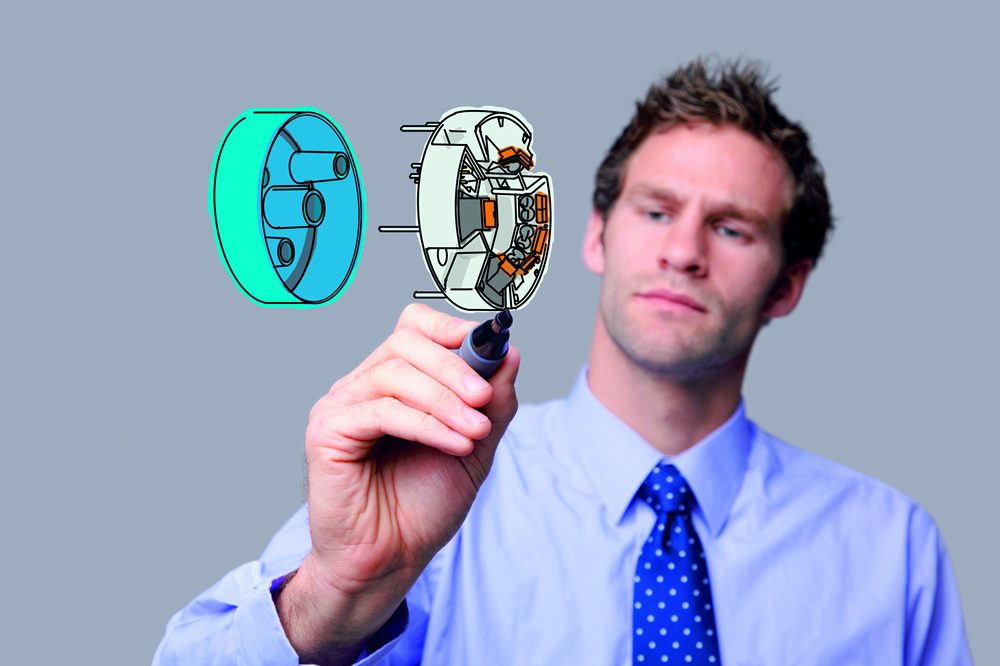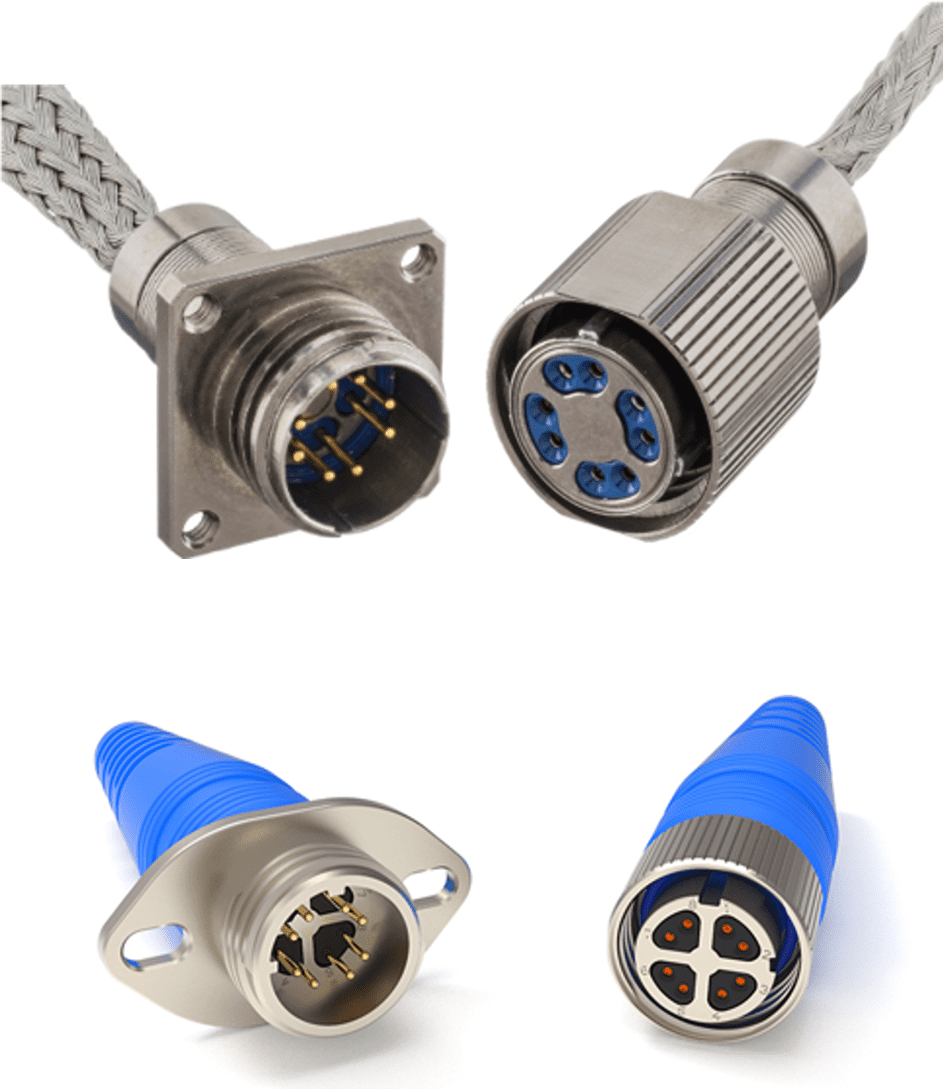Customization Takes Many Forms to Meet Changing Connectivity Demands
The quest for greater performance and functionality in smaller and lighter connectors has sparked some creative customization solutions.

Custom connector solutions are usually a last resort, but with the pace of change in the world of technology, off-the-shelf options can’t always keep up. Customization fills a need when the right solution doesn’t exist yet.
“There are any number of reasons to choose a custom solution,” said Michael Schreiner, manager of DC solutions, engineering and market development — device connectors, at Phoenix Contact. “The need may come from a new technical challenge or an issue specific to an industry or an application. It can result from new standards or regulations that have been instituted. It might be necessary if an application requires a combination of attributes that isn’t currently available, such as a certain voltage and current, or a specific configuration with certain physical dimensions.”
In addition to solving a specific problem, Schreiner said, customization typically gives the customer a competitive advantage in the marketplace, by introducing a new feature set or distinguishing the product from its competitors.
At Phoenix Contact, the customization process starts with evaluating five key elements: timing (the customer’s schedule), turnover (how many units the customer is going to buy), target price (this determines whether the project makes economic sense for the customer and the supplier), tooling (the machinery and parts needed to build the custom product), and the problem (what they are trying to solve).
Tooling is an important piece of the process. “Typically, tooling involves injection molds for the plastic components, stamping and forming dies for the metal components, and some sort of assembly fixturing. That can be anything from a hand assembly operator sitting at a bench up to a million-dollar piece of factory automation with robots putting parts together,” Schreiner said. Tooling and unit cost are directly related; typically, a higher up-front investment will yield a lower piece price.
While customers often come in with a connector solution in mind, Schreiner suggests starting with the problem. “A much better approach is to tell us what you’re trying to solve. Then we can take a fresh look and come up with a truly creative solution,” he said. “Because we have expertise in our product and all the subcomponents, we understand assembly and automation, and the limitations of tooling. We incorporate that knowledge into our process.” Ultimately, the goal is to achieve success by balancing all the physical and economic pieces of the customization puzzle. “I tell customers all the time, we can create the best widget in the world, but if it prices your product outside of a competitive position in the marketplace, it’s going nowhere.”
One way to cut costs, he said, is to minimize the amount of customization in a particular design. “We try to use as many existing subcomponents as we can. This speeds up the project, minimizes technical and commercial risk, and reduces the investment in tooling and in engineering.”
In some cases, customization can be the less expensive option. “Occasionally we find that customers specify products that exceed the requirements for their application. For example, they need 60 amps, but the closest connector they can find that hits all the other checkboxes is 75 amps. Developing the right size solution rather than specifying something that is overkill for the application may be more cost-effective,” said Schreiner.
Additive manufacturing, rapid prototype tooling, and other technologies such as chemical etching and sintering for making metal parts, are making the customization process faster and easier. Still, Schreiner said, it’s important to consider all aspects of a custom development and not to make quick decisions by simply comparing unit costs of custom products to something that is available commercially off the shelf. “Ultimately, it all comes down to a value-based decision. Our objective is to provide value that far exceeds any incremental cost associated with a custom solution.”
Modular connectors facilitate customization
Modularity is a way to customize a connector solution more easily, quickly, and cost-effectively. Amphenol Air LB’s SIM (EN4165) series, commercialized by Amphenol Pcd for the U.S. commercial air and military markets, allows customers to maximize an application’s given space envelope and combine the necessary functionality, including power, signal, and fiber optics. The system has high-density signal modules, RJ45 modules, grounding modules, shunt modules, and inserts with mixed layouts.
“The big benefit of this connector system is its flexibility. Customers can easily choose the components to configure and assemble the connectors they need,” said Kolja Lucke, head of BDM at Amphenol Air LB. “For a customer who isn’t familiar with this connector system, we can assist with putting together the connector that the customer needs.”
The outer shells can be made to fit the customer’s space envelope while using standard inserts which all have the same cavity dimensions. The inserts all have the same outer dimensions. “We always start with existing standard components, and only if necessary create those components that are missing, still using existing parts as much as possible,” Lucke added.
Custom also means optimization or improvement
Until about a decade ago, airline passengers couldn’t use their cellphones or other connected devices on board a flight. The level of connectivity that is common today was not possible because airplanes were not equipped with the electronics infrastructure to accommodate it. “Connectors that hadn’t existed previously had to be invented,” said Harry Fenton, product manager of custom connectors at Carlisle Interconnect Technologies (CarlisleIT).
Today, connectivity on a flight is not only possible, but also expected, as is access to more varied in-flight entertainment (IFE) options, which require even greater amounts of data. Passengers can connect to IFE via their own devices (phone, tablet, or laptop) or with a screen in the seat. CarlisleIT provides the antenna infrastructure (radomes and mounting plates), the cables, and the connectors that are necessary to make that connection possible. “There is a lot of customization for IFE connectors because there is no single standard that defines a common configuration to be used specifically for all IFE applications. The physical shape and size of the part that connects the wires carrying the signal can vary due to specific requirements from manufacturer to manufacturer,” said Fenton. “The most requested design needs are for small size, lighter weight, smaller gauge wire, and easy repairability. Customization comes into play when determining how to combine signals, cables, and data part configurations in different ways to achieve the smallest package size. The challenge is to provide not only today’s high data transfer rates, but also deliver the capability to grow for the future without connector and cable replacement.”

Carlisle IT’s Octax connector series is designed to provide high density 10 Gb/s data transmission in the lightest, smallest connector size. Shown here: Octax Solo (top) and customized Octax LT.
Octax LT is an example of customization of an Octax Solo connector for an OEM IFE application. The changes from Solo to the LT include aluminum base material, unique two-screw flange mount, unique clocking and insertion features, and rugged overmold. The result is a rugged, repairable, low cost, lightweight, 10 Gb/s data connector that can meet the performance of today with range to grow to meet the needs of future data speeds and volume.
Octax connectors can be customized to provide multiple data ports applied to a range of connector formats from the small form Octax Solo and Octax LT to industry standard EN4165 formats to large commercial aerospace and military MIL-DTL-38999 shell configurations. The Octax design increases the density of data transfer within the defined diameter, shape, and size of this connector style. The Octax hybrid connector combines discrete signals and data signals in the same small space. “Think of it as similar to the volume of water from a firehose being pushed through a garden hose, without losing performance and integrity of the connections or signal carrier. The signal stays within the transmission carrier, the wire. The data moving through the wire must be condensed while maintaining signal integrity,” Fenton explained. “This customized connector has features that allow us to combine many different signals in a much smaller package, including signals that potentially can corrupt other signals.”
New interconnects must have the same or better performance than their predecessors and advancements in customization options speed the development process. “Electronics evolve quickly. Whatever was in service five years ago looks like a stone axe compared to what’s being made today,” said Fenton.
To learn more about the companies mentioned in this article, visit the Preferred Supplier pages for Phoenix Contact, Amphenol Pcd, Amphenol Air LB, and Carlisle Interconnect Technologies.
Subscribe to our weekly e-newsletters, follow us on LinkedIn, Twitter, and Facebook, and check out our eBook archives for more applicable, expert-informed connectivity content.
- Sealing Success: Overmolding for More Secure Connections - April 23, 2024
- Medical Cable Assemblies Product Roundup - April 23, 2024
- Mezzanine Connectors Product Roundup - April 16, 2024






